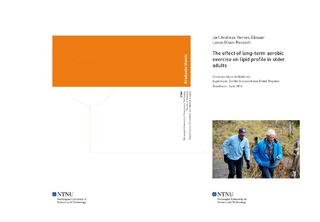| dc.description.abstract | Abstract
Background: Ageing is associated with higher risk of abnormal lipid regulation
(dyslipidemia), and reduction of lipid levels is one important strategy to reduce risk of
cardiovascular diseases (CVD). It has previously been shown that exercise can improve lipid
profile, but the optimal intensity and volume in older adults are still unknown. In addition,
few studies have investigated the long-term effect of exercise on lipid levels in people with
manifested dyslipidemia.
Aim: Our study’s aim was to test how three years of high intensity training (HIT) and
moderate intensity training (MIT) affect lipid levels in older adults. Further, to investigate
how individuals using cholesterol lowering medications (CLM) respond to different training
intensities, when looking at lipid levels.
Method: A total of 413 participants (215 women), aged 69 to 76, were divided into two
groups; general population not taking CLM (GP group, n=336) and those taking CLM (CLM
group, n=77). All were then randomized into three intervention groups, either HIT (n=102) or
MIT (n=99) a minimum of two times per week, or a control group (n=212). The control group
were advised to follow the 2012 Norwegian Health Directory guidelines for physical activity.
Results: In the GP group, triglycerides (TG) decreased in HIT (-0.14 mmol/L) and MIT (-
0.12 mmol/L). Total cholesterol (TC) decreased in HIT (-0.21 mmol/L). Low-density
lipoprotein (LDL) and high-density lipoprotein (HDL) remained unchanged in both training
groups. A significant between group difference was found in changes in HDL levels between
HIT and MIT. In the CLM group, TG decreased in HIT (-0.12 mmol/L) and MIT (-0.23
mmol/L). The TC in the CLM group decreased in MIT (-0.61 mmol/L). No between group
differences regarding lipid values were found in the CLM group.
Conclusion: Our study shows that for the general population HIT for three years gave most
favourable changes in lipid profile, as both TC and TG decreased. Importantly, three years of
MIT also decrease TG levels. Contrary, in CLM users, three years of MIT decreased TC
levels and TG levels, while HIT only decreased TG levels. Altogether, our data show that
exercise could be an important strategy to improve lipid levels in older adults | nb_NO |
